
The St. Luke's Story
The St. Luke’s Medical Center – formerly known as Saint Luke’s Hospital, though originally established as Cleveland General Hospital, which was founded on January 30, 1894. The hospital was opened with 75 beds, initially situated on Woodland Ave. At this time, the hospital’s main purpose was to provide training to students studying medicine within the medical department of Wooster University; the hospital would also provide training for nurses. This was just the beginning of an incredible Cleveland medical clinic, which would come to bring some greatly important things to our world.

The day I visited Saint Luke’s, it was brought to my attention almost as a perfect accident. Driving slowly down Shaker Blvd. under the bright mid-day sun, a tall, crumbling clock tower caught my eye. The tower stuck out like a sore thumb, looming over the neighborhood – milk glass broken from its clock face and copper torn from the top. I was taken away when my eyes followed the clock tower downward, only to see the largest abandoned structure I had witnessed to date. It was the summer of 2010, and up until this point, my experience in exploring abandoned buildings was fairly limited – mostly to 4 years of forgotten farm houses, empty factories and some busted apartment complexes. I had yet to explore much within the city, and had never seen something as massive as this hospital, let alone imagined that a structure this monumental could just become abandoned. The fact that this sat so close to home was a great bonus, being that photographing abandoned places had become somewhat of a passion for me.

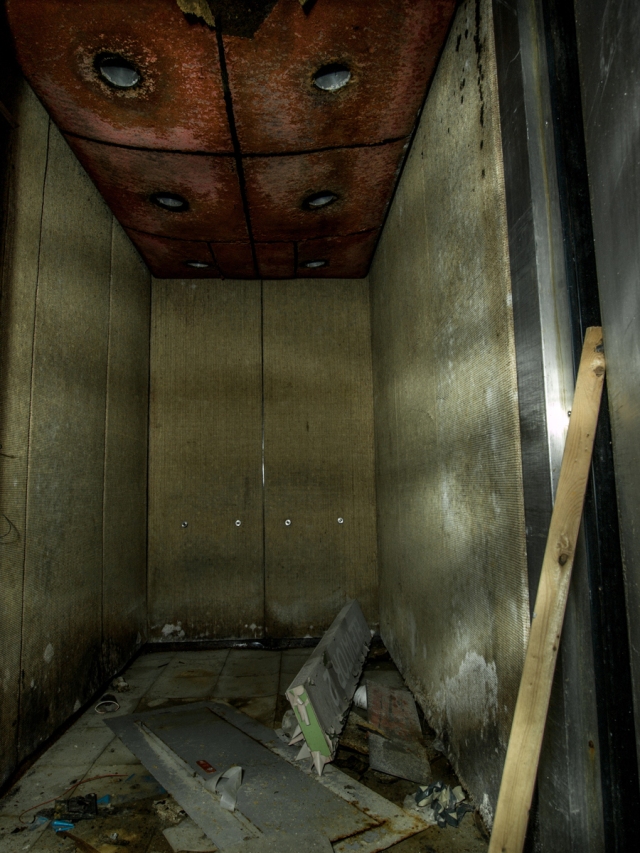
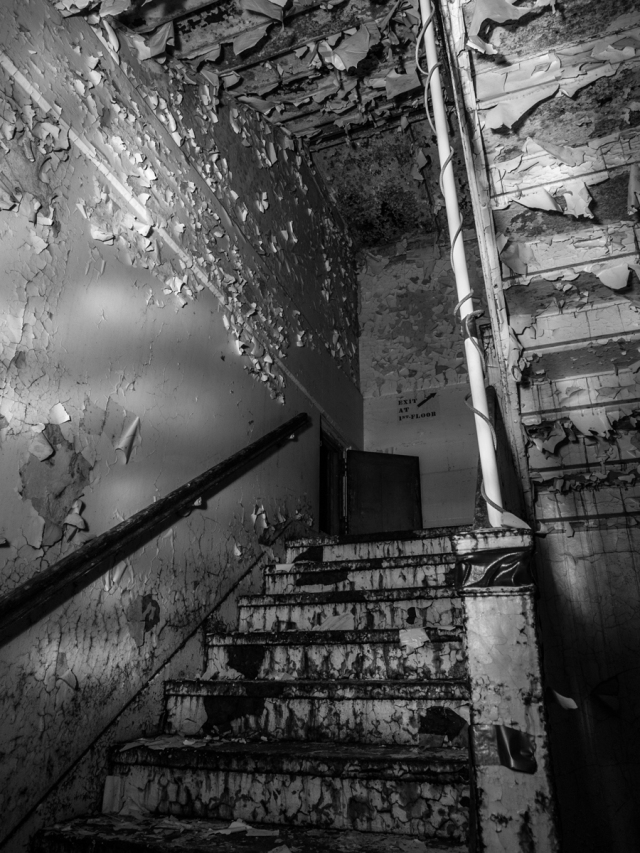
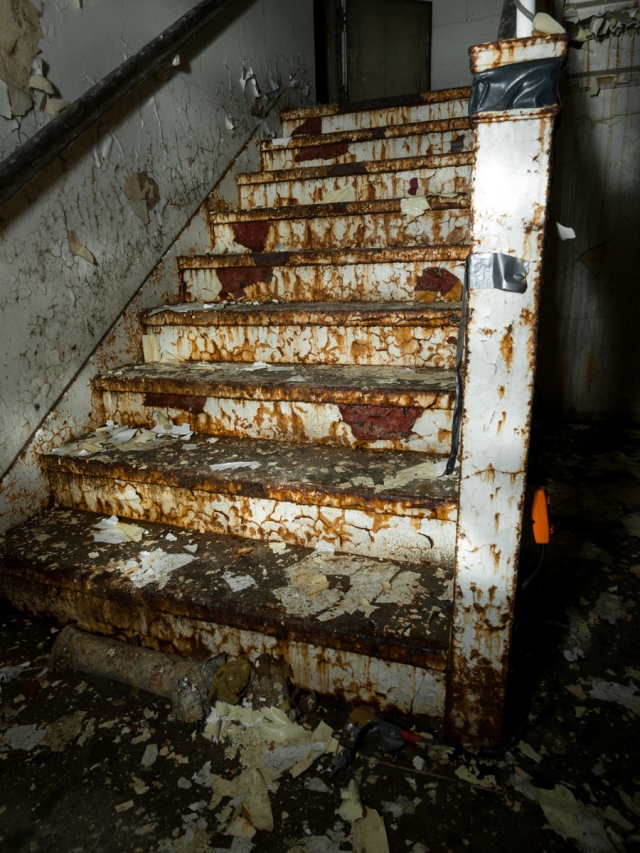
St. Luke’s hospital was – and always will be – one of the most eye-opening explorations for me. Over the course of two summer days, I learned that could such a colossal, historically important structure could be left to rot, but that the history behind these places was just as interesting as the peeling walls, water damaged floors and eerie decay to be found within them. Simply observing this hospital from the outside, seeing it in such a state of decay sent my thoughts all over the place; I knew that I had to photograph whatever sat inside.
Having grown far too curious at this point to let this place slip away, we were ready to do whatever it took to make our way in. My friend and I wandered outside of the structure for at least an hour, searching for a way in, and avoiding being seen by the very obvious contractor’s stationed at their trailer. We tried all we could to sneak in with no luck. After realizing that going about it this way was most likely the worst way, we decided to walk straight to the contractor’s trailer, knock on the door, explain why we were interested, and hope for the best. To our surprise, we were greeted by a group of three friendly workers, welcoming us into the trailer, and giving us a run through of some of the building’s history. After further explaining our interest that we had in old, abandoned structures, it seemed that we had gained a significant amount of respect from those working on the restoration project. We had requested to photograph the building’s interior, and after a short talk, the people in charge actually cleared our request and agreed to let us in.
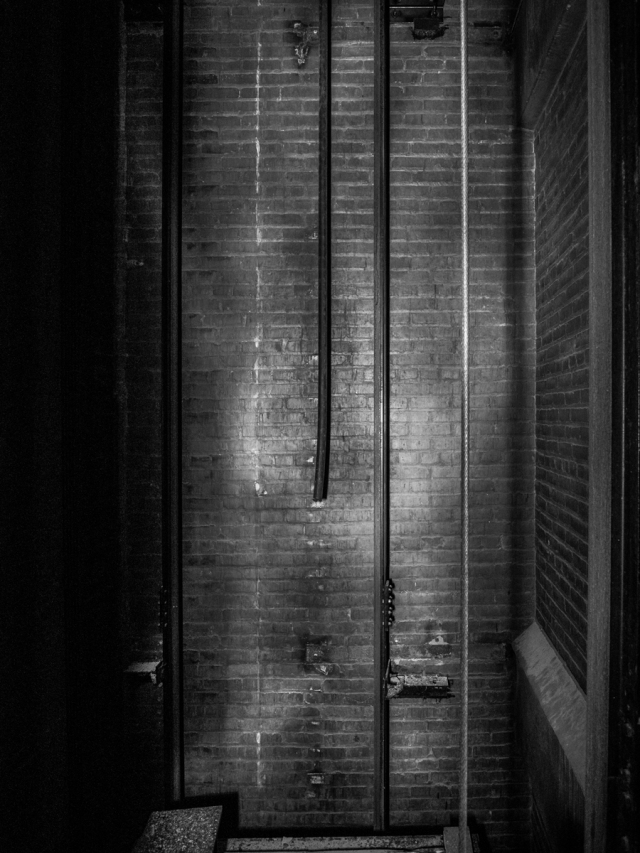
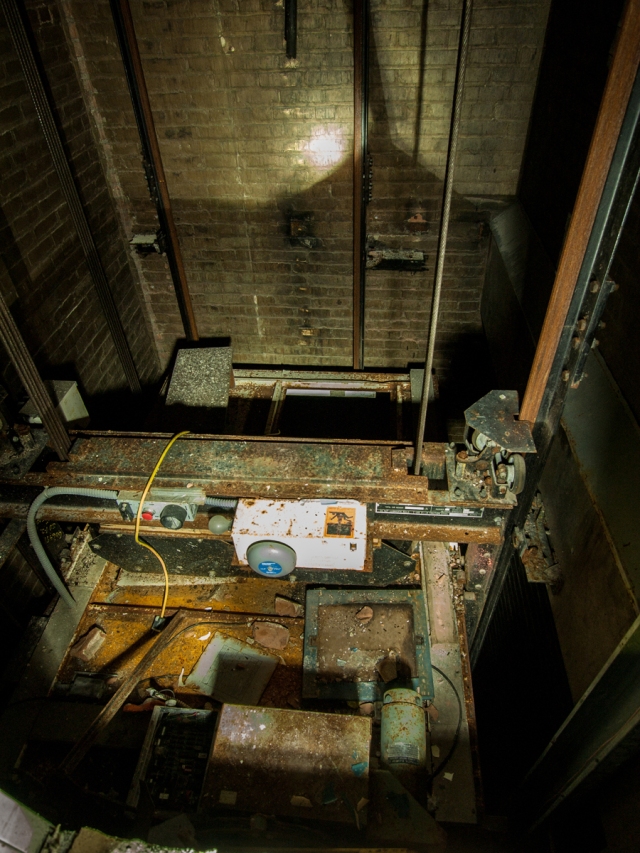


“Come back in the morning, and I’ll unlock the doors for you guys to see the place.”
I’m pretty sure hearing those words sent a bit of an adrenaline rush through me, because never would I have imagined I would hear those words after having made that request – especially for such a massive and somewhat dangerous place. We arrived early in the morning, and were guided to park in an empty dirt lot, which today holds a much more visitor-friendly parking lot. With keys in hand, the contractor led us from this lot, towards the massive, abandoned structure. The experience of exploring this enormous hospital quickly became even more incredible when – to our surprise – we were given permission to wander freely through the building on our own. Later in our adventure, we joined back up with the contractor. He asked us if we would like to be shown to the library (or what they called “the mold room”) theatre and clock tower; who would really say no?
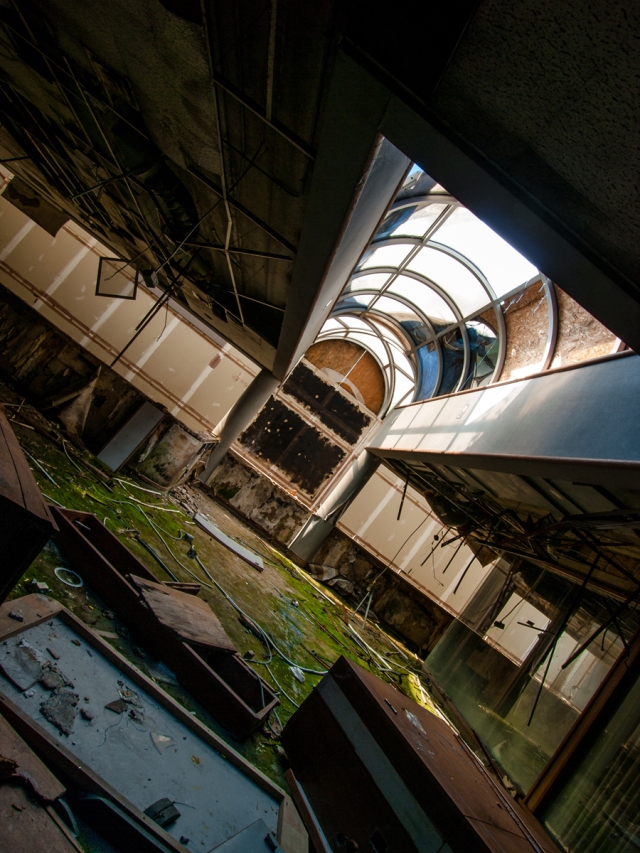
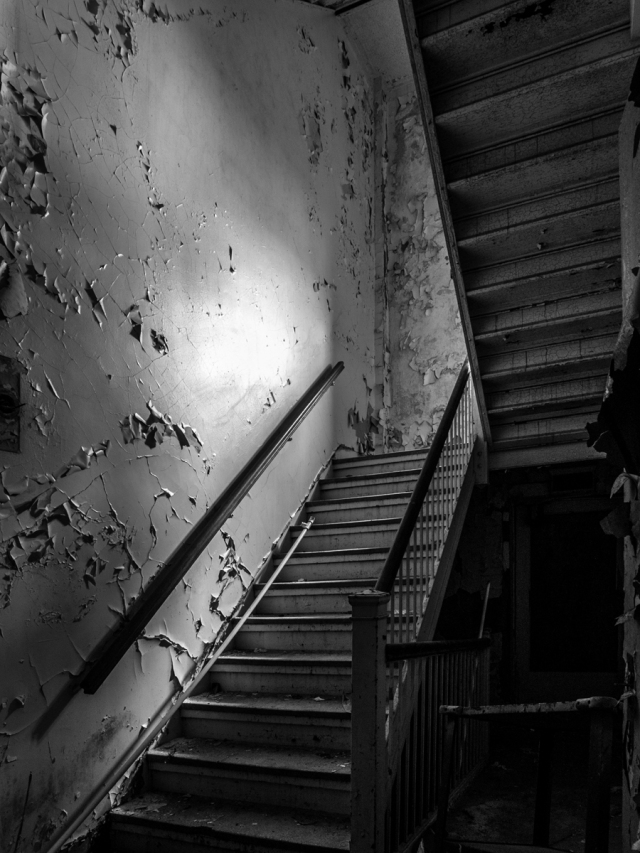

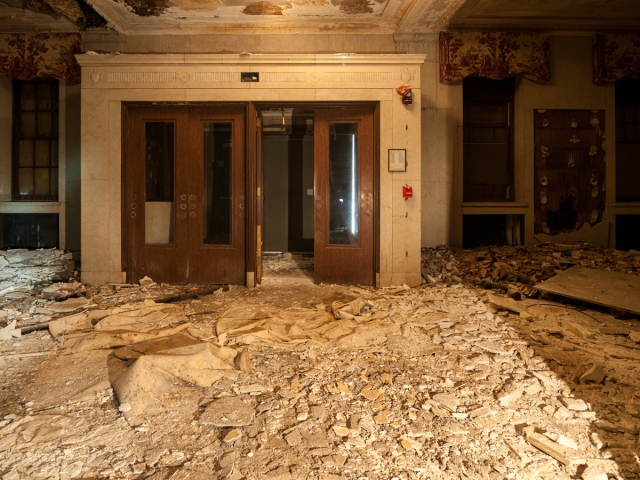
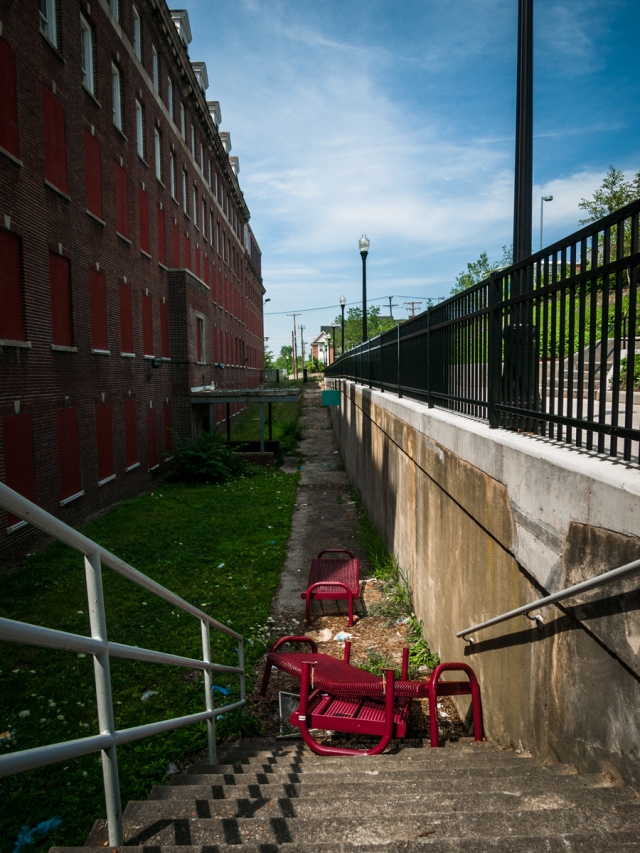
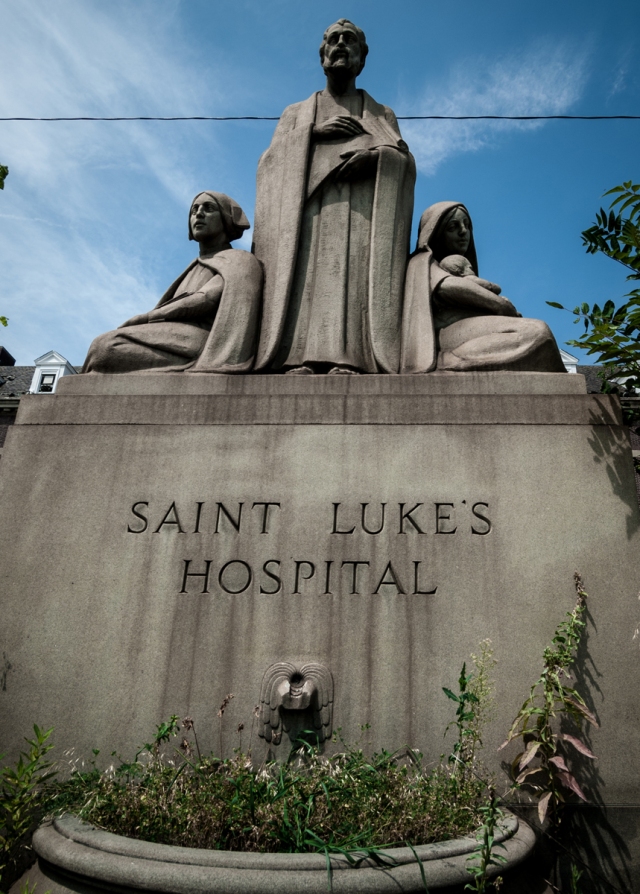


Upon our arrival to the clock tower’s bottom level, we were greeted by one hell of a climb. An old, rusted ladder hung above deteriorating vent systems, while a splintered collection of wooden planks acted as the only walkway over to the ladder. Grabbing hold of metal rods to pull our way up, we carefully brought our way onto the wooden planks. From this point, it was only a short walk to the crumbling ladder. Though things were already looking structurally questionable, we both figured that we could put our trust in the contractor, who initially gave the okay to climb (more or less telling us that we HAD to see the inside of a clock tower.) The ladder stood freely, with a drop leading straight down to the tops of decaying air systems. Now carefully making our way onto this rusted, rickety ladder, we climbed the final bit leading towards the clock’s main gears, situated close to the tower’s top. From inside the tower, I could now see where the milk glass was broken from each clock face. The glass lay scattered across antique wood floors, while chains rusted chains hung from equally as deteriorated gears.
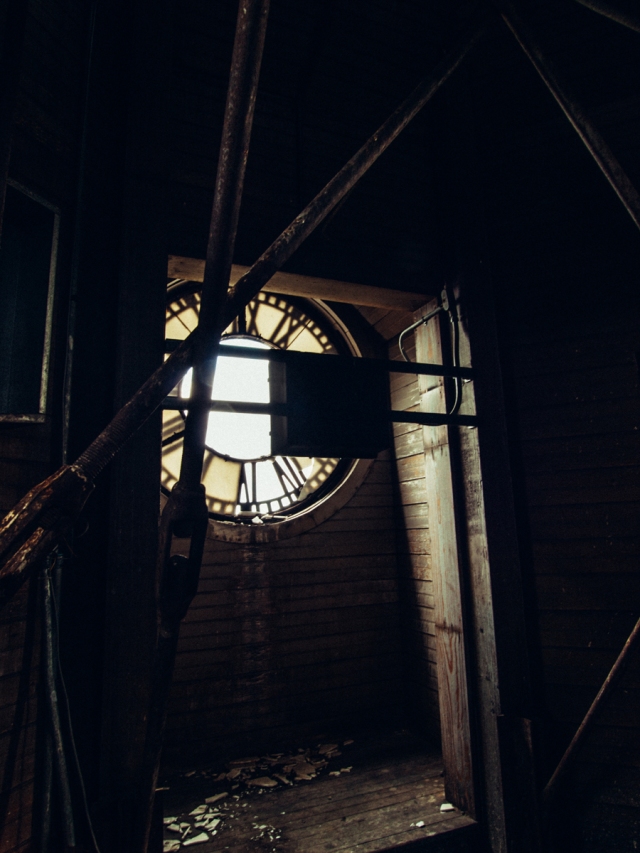




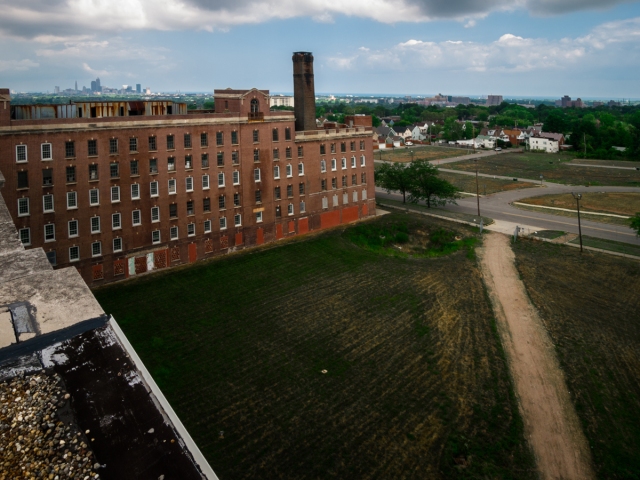
Throughout the entire building – from top to bottom – entire stairwells sat coated in peeling paint from ceiling to floor. We wandered up and down flight after flight of stairs, passing each crumbling corridor as we ascended and descended the stairwell. The halls remained noiseless aside from the echo of our footsteps reverberating, and a ‘pat-pat-pat’ of distant dripping water from within the black abyss of labyrinthine hallways. Paint chips crunched beneath our feet with each step, throwing soft echoes into the normally muted maze this hospital had become.
Hallways had been stripped of their elegance, and thrown into a state of disrepair by 11 years of neglect as nature also took a toll. Staring down some corridors, you could see that the entire ceiling had come crashing to the once beautiful floor; it appeared as though numerous groups of people joined together in one hallway, attempting to eat Nature Valley granola bars. Paint curled from walls, reaching out into the darkness, with busted railings on both left and right through walkways.
At this time, exploring abandoned structures was not as hyped up in the United States like you’ll find in today’s society. Many people thought it strange that we enjoyed climbing around, and hanging out in the dirty, broken pieces of our country’s past simply to take photographs and could call it “fun.” Truth is, exploring St. Luke’s is an experience that I will hold onto forever.
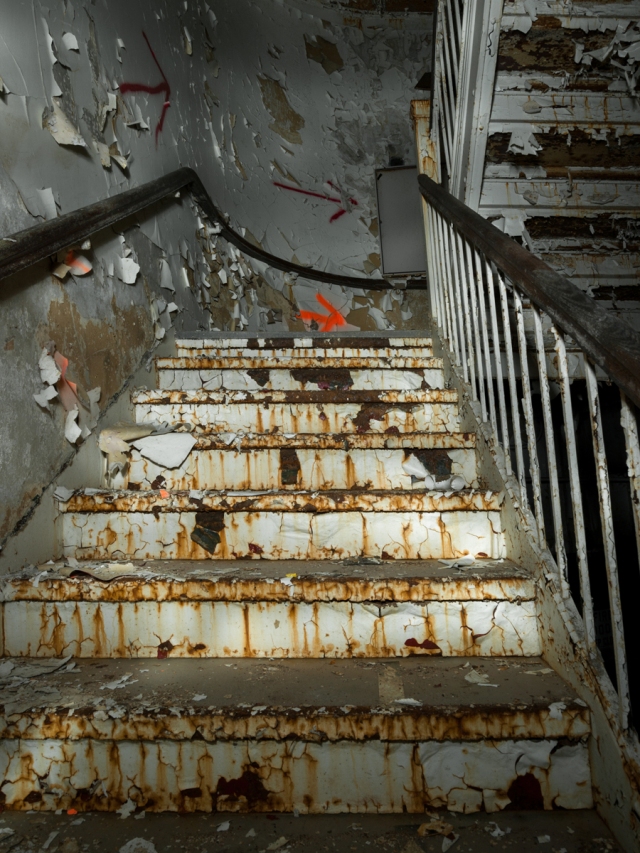
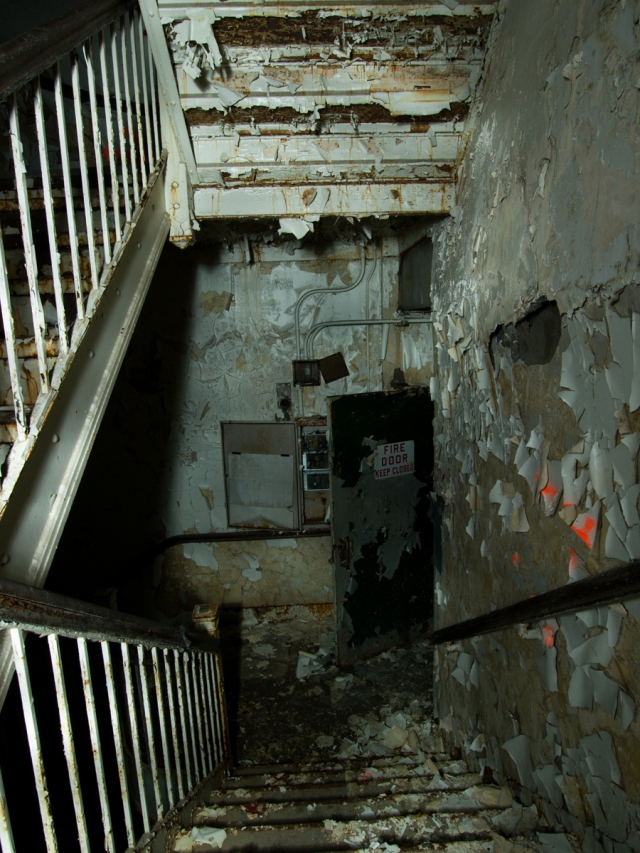


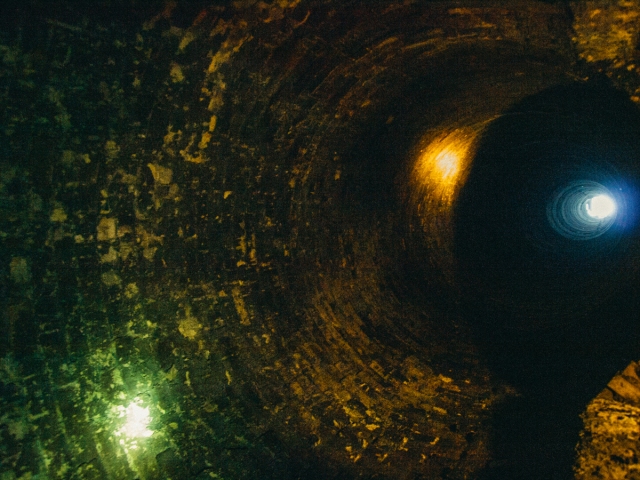


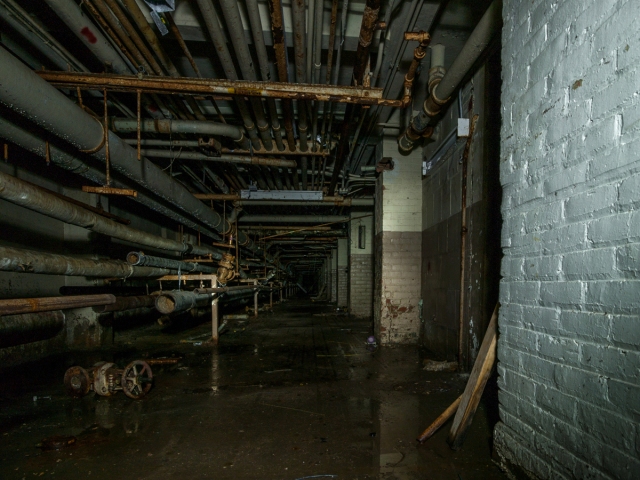
Later, I had come to find that it was this very hospital where my grandfather spent his final moments. I had never known him too well, being that I was only a few years old when he passed away.
Francis Fleury Prentiss and his wife, Elisabeth Severance Allen Prentiss were two of the first presidents to Saint Luke’s, providing great financial support for the realization of many projects, including almost anything relating to the Saint Luke’s campus. In 1906, Francis Prentiss called for the name of Cleveland General to be replaced by what it is known as today. Though today it may remain a home for the elderly, along with a connected school, the name “Saint Luke’s Hospital” still floats along the still air of its quiet corridors.
During the year of 1906, Saint Luke’s purpose had changed. Once heavily used by students of the medical field, rather than a full on hospital, the building would now hold a purpose to “conduct a general hospital and school of nursing.” In 1908, medical activities were moved to a brand new, 120-bed location, now placing students and patients in a facility on Carnegie Ave. near E. 66th Street. With the passing of only two years, patient capacity was at a heavy rise with the addition of 60 more beds, along with the integration of the Cleveland Maternity Dispensary.
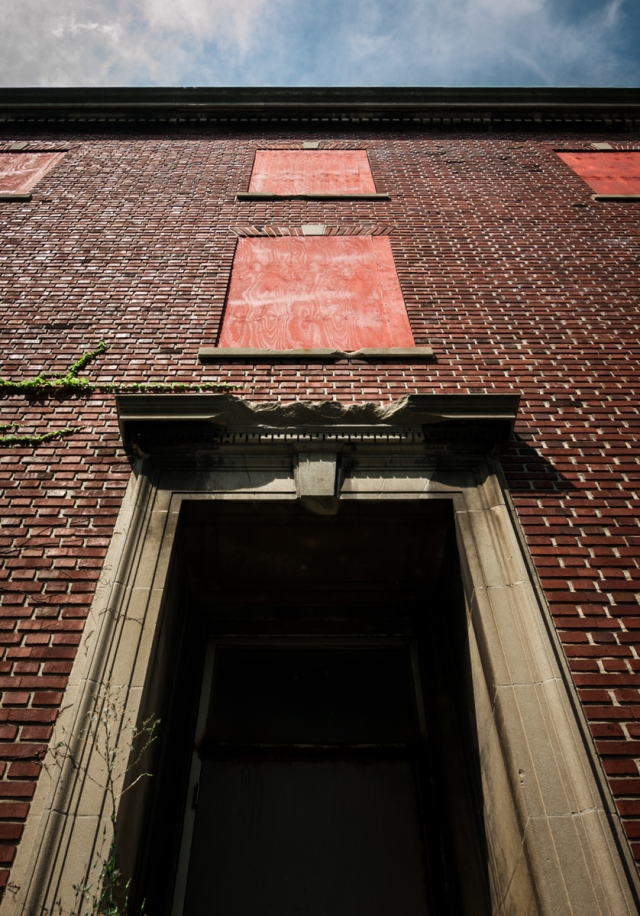


In 1927, the hospital would once again move for the final time – this time to a much larger and much more permanent location on Shaker Blvd. This year, Cleveland welcomed the massive, brand new St. Luke’s Medical building that we all know today. The new structure was heavily financed by Elisabeth Prentiss. At the time of its completion, the hospital held 40 physicians on medical staff, along with 12 on house staff, and an incredible 125 nurses.
Numerous expansion projects carried St. Luke’s into the 1980s. These projects included the 1942 expansion with addition of a central service wing, offering a space for furthering medical and surgical research, as well as a dietary department, purchasing and accounting areas. The nurses’ residence was completed in 1948 and opened up the East wing of this growing building, finally enabling the hospital ability to further increase bed capacity. From 1963 to 1975, construction was completed on two other buildings. Between these years, opportunities began to open up for Saint Luke’s as they partnered with Cuyahoga Community College in 1964, and later, Kent State in 1968. Saint Luke’s was able to close their own school of nursing – now being partnered with multiple schools – allowing them to repurpose space within the hospital for other use.
Earlier graduates of Saint Luke’s training school for nurses were some of the very first to practice public-health nursing within the city of Cleveland. Saint Luke’s also held one of the most advanced and innovative Obstetrics division of its kind from the years 1910-1938, held under the supervision of Dr. Arthur Skeel. As if all of this weren’t already impressive enough – come 1952, Saint Luke’s would become the originating source for studies in emphysema and cardio circulatory problems. Only four years from beginning this type of research, the hospital would become home to the very first heart-lung machine – developed by Dr. Earl B. Kay and Frederick Cross.
The photo you see here (taken April 1, 1956) is actually the two doctors making adjustments to the very first heart-lung machine the country would see come to completion.
Things seemed to continue looking up for Saint Luke’s as they merged with MetroHealth Medical Center in 1992, now making the facility MetroHealth St. Luke’s Medical Center. However, after only one year this brief merger was dissolved in May of 1993; an affiliation between the two still continued. June 1993 would welcome a final name change for the facility, when St. Luke’s Hospital became St. Luke’s Medical Center.
One of the country’s largest medical centers would soon be headed steadily downhill. The hospital hit a small bump in the road when the MetroHealth merger was dissolved, but in 1994 St. Lukes would run into a pothole big enough to swallow a car when they lost their contract to treat Kaiser Permanente patients. This was about to send the hospital’s finances into a steep decline as Kaiser Permanente patients represented 30% of their patient population. As a result of the loss of this contract, Saint Luke’s was forced to lay off 213 workers in January of 1994. In July of the same year, the hospital would attempt an uphill climb to rise from this hole, entering into an agreement with Blue Cross & Blue Shield of Ohio. This allowed St. Lukes to accept patients from the Blue Cross “Super Blue” health management plan. The hospital held steady for a while from 1994-1999 as things seemed to start looking up. Through these years, St. Luke’s remained a major teaching and research hospital, holding 474 beds. In 1997 the facility was sold to Columbia/HCA Healthcare Corporation and its Ohio partner, the Sisters of Charity of Saint Augustine.
It wasn’t until May of 1999 when things took a turn for the worst, and the hospital was forced to close its level two trauma center, sending it into a quick downward spiral – something similar to a Mike Tyson knockout; I mean, if buildings were able to feel pain I suppose. An announcement was also made that the facility would be closing its medical and surgical operations by the end of June. An attempt was made to transfer the hospital’s 120-bed mental health facility – however, plans for this were quickly dismissed and scrapped, leading straight into full closure of the hospital in the summer of 1999. Over 800 people were employed at the time of St. Luke’s closure, leaving many out of work, and a building to rot. For many years, St. Luke’s sat quiet and empty, open to the elements and weathering of time.

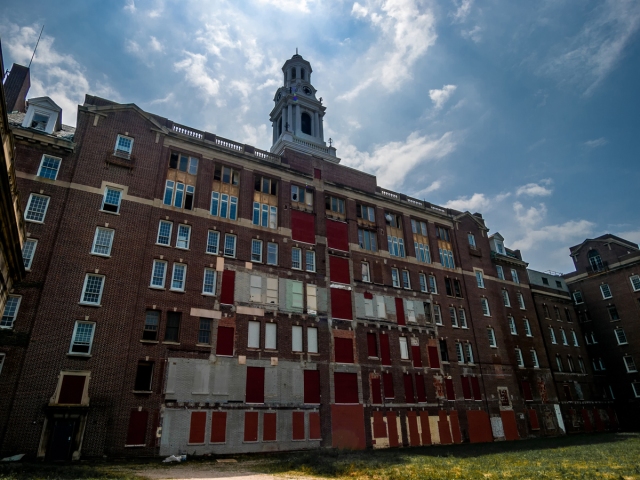

It’s difficult to even fathom that this project came to completion over the course of two years, when a ¼ mile stretch of freeway can sit unfinished – or at times, barely touched – for two years or longer at a time. With the entire $54-million-dollar project dealing with the clean up of asbestos and debris, scraping peeling walls, replacing and wiring new electrical, restoring broken pieces of architecture, replacing windows, cleaning up brick and sidewalks, building new sidewalks and parking lots, rebuilding walls and structuring/constructing rooms, fixing and replacing pipes and water systems, replacing heating and air conditioning systems, restoring the theatre and library to create a brand new school and hiring an entire staff to keep the place alive – it’s almost impossible to believe everything happened in only two years. Truly an incredible feat accomplished and brought vibrantly to life by an amazing team of dedicated people.
I believe that the life and story of St. Luke’s Medical Center should never be forgotten.







Good morning! What is the password?
~~Sent from my IPhone~~
>
Hey! The story will be available publicly in two weeks, though contributors to the Patreon profile have received a password for early viewing. The Patreon page kind of currently acts as a “membership benefit” kind of thing. Not only do contributors receive early access to pieces like this, but also pieces that will never be shared (both new and old pieces) that just simply will never see the light of day – as well as photos that will never be made public with information on why they were taken and what they helped me learn as a photographer. Included as well will be (for photographers) tutorials done by request and the like. Contributors of different levels will also receive different monthly gifts, etc. – if you want you can check it out here 🙂
https://www.patreon.com/JohnnyJoo?ty=h
This will not only give you cool things but help in the support of furthering these projects, bringing larger and better projects, pushing towards creation of some awesome material such as books and the like, and also giving back to the community in ways explained within the patreon page.
Hi Johnny,
Thanks for your wonderful photography and hard work bringing to light these abandoned buildings.
Is the password currently available for access to to this story? This post and the related one a couple of days back both being password protected means I can’t get access.
Cheers,
Roz
> >
Hey Roz,
This story will be available publicly in two weeks, though contributors through the Patreon profile have received a password for early viewing. The Patreon page kind of currently acts as a “membership benefits” kind of thing. Not only do contributors receive early access to pieces like this, but also pieces that will never be shared (both new and old pieces) that just simply will never see the light of day – as well as photos that will never be made public with information on why they were taken and what they helped me learn as a photographer. Included as well will be (for photographers) tutorials done by request and the like. Contributors of different levels will also receive different monthly gifts, etc. – if you want you can check it out here 🙂
https://www.patreon.com/JohnnyJoo?ty=h
This will not only give you cool things but help in the support of furthering these projects, bringing larger and better projects, pushing towards creation of some awesome material such as books and the like, and also giving back to the community in ways explained within the Patreon page.
If you have any other questions, please feel free to email me at urbexus@gmail.com
Thank you 🙂
I’m not sure why I have shed so many tears over photos. I guess I look at them now and try to remember how they once were. I have really enjoyed looking at your gallery photos!
Hello! I work at Dittrick Museum and we are trying to source the image of Kay and Cross; where did that one come from?
Brandy
Reblogged this on Hauntedlady's Blog.
Thank you for this story. it is heartbreaking to see these type of places go to ruin!
My grandfather, Ivan Blaze, along with the two doctors in the photo was the Head of Surgical Research at St Lukes Hospital. He was never credited for any of his work on the heart lung machine that keeps so many people alive.
I would love to see any records or photos of him with the two Drs. I saw a picture once yet not sure its origin (hospital publication or newspaper).